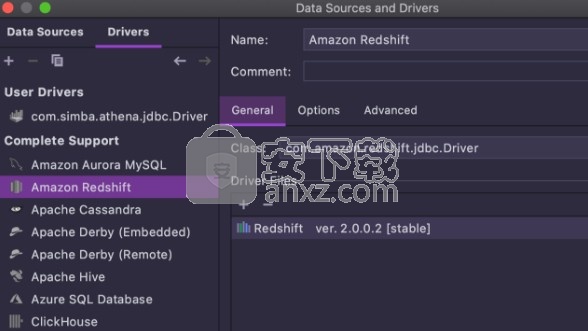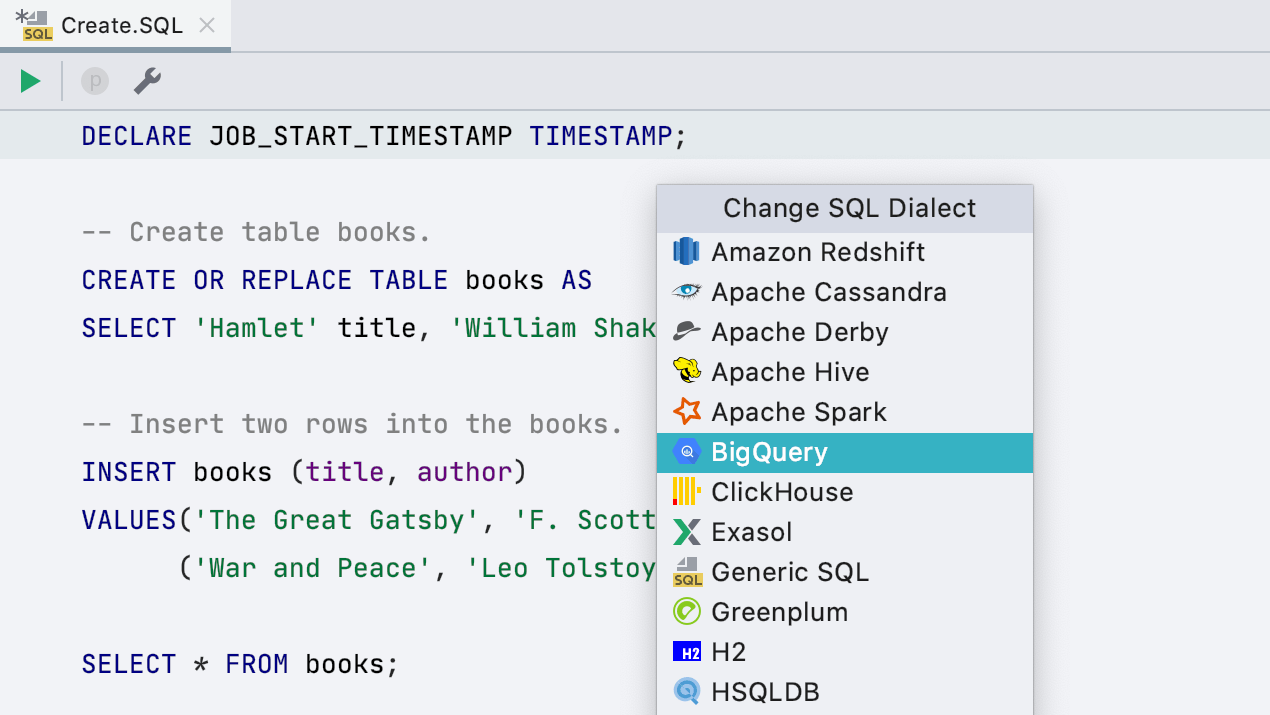
- DATAGRIP BIGQUERY HOW TO
- DATAGRIP BIGQUERY ZIP FILE
- DATAGRIP BIGQUERY ARCHIVE
- DATAGRIP BIGQUERY PASSWORD
While you can use any GUI that supports BigQuery, such as PopSQL, Tableau, or DataGrip, we will use the BigQuery console to execute our queries for this article. Notably, snarks and user transactions (aka user commands), which are also nested in blocks data, are separated into their own tables for easier querying. The schema of the BigQuery dataset matches that of the MinaExplorer GraphQL API. Data is replicated from MinaExplorer's database (which stores GraphQL subscriptions) with a small latency of no more than a few minutes. Google BigQuery is a cloud-based big data analytics web service for processing very large data sets.
DATAGRIP BIGQUERY ARCHIVE
MinaExplorer has published its custom archive node dataset to Google BigQuery as a public dataset to resolve this issue. While obtaining this information via scripting is possible, directly querying a database with a SQL query is more accessible and efficient. However, neither offer simple aggregation features to answer questions such as "how many blocks were produced in the last 24 hours". Those who want to query historical data without running their own archive nodes (and associated Mina node(s)) can use historical services like Figment's DataHub or MinaExplorer's archive GraphQL API.
DATAGRIP BIGQUERY HOW TO
See this post on how to set up and configure an archive node for redundancy. The official implementation of an archive node stores its data to a Postgres database, which typically requires the use of recursive queries to determine the canonical chain information. So, if we want to analyze the chain's history (for example, to see individual transactions), we need to obtain it from an archive node. Mina is a succinct blockchain, which means while we can verify the chain's current state using a zero-knowledge proof, the prior history is not retained.
DATAGRIP BIGQUERY ZIP FILE
Google User Account using OAuth 2 (OAuthType=1) Using pregenerated access and refresh tokens (OAuthType=2) Using the Application Default Credentials in your environment (OAuthType=3)įor more information about setting up these authentication methods please refer to the Simba JDBC Driver for Google BigQuery installation guide from the zip file earlier in the post.An Introduction to MinaExplorer's BigQuery Public Dataset It is also possible to use other authentication methods to connect to BigQuery including: There a number of other options that can be customised for the JDBC driver by selecting ‘Advanced’ in the Data Source connection.

TroubleshootingĬheck that your OAuthServiceAcctEmail and OAuthPvtKeyPath are set correctly and you’ve specified the absolute path to your key. Hit the ‘Test Connection’ and if everything has been set up correctly Datagrip should notify you that the connection has succeeded. Jdbc:bigquery:// ProjectId=PROJECTID OAuthType=0 OAuthServiceAcctEmail=EMAIL OAuthPvtKeyPath=KEYFILE ) associated with the service account and KEYPATH is the absolute path to your keyfile (e.g., /Users/mike/Downloads/example.json) – both. Where PROJECTID is your Google project ID, OAuthType=0 (for service account authorisation), EMAIL is the email address (ending in.
DATAGRIP BIGQUERY PASSWORD
Leave the user and password fields blank.Enter the name of your datasource in the Name field.In the data sources window hit ‘+’ and select BigQuery.

Next let’s set up a data source to ensure we can connect. This concludes setting up the JDBC driver for BigQuery. Name: default Template: jdbc:bigquery://: ProjectId= OAuthType= Under ‘Class’ select 42.DriverĬlick the ‘+’ icon in URL templates and add the following URL template: Under ‘Additional files’ click the ‘+’ icon and browse and select the all the jar files (ending in *.jar). If you aren’t sure if this is the case navigate to IAM, select your project and edit the role associated to the service account (e.g., BigQuery -> BigQuery Data Editor/Viewer) Setting up the BigQuery driverĪdd a new data source by clicking on the ‘+’ icon, select ‘Driver’ – the second last option in the drop down menu.Įnter ‘BigQuery’ as the name of the data source. You’ll need both of these pieces to setup the BigQuery connection.Įnsure that this service account has sufficient permissions to access BigQuery. Take note of the email address and the associated key pair with this account. If you don’t have one setup you can find instructions here. You will also require a Google service account that has access to BigQuery.



 0 kommentar(er)
0 kommentar(er)
